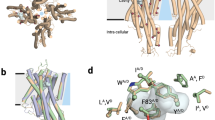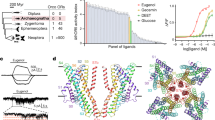Abstract
Despite increasing knowledge about dimerization of G-protein-coupled receptors, nothing is known about dimerization in the largest subfamily, odorant receptors. Using a combination of biochemical and electrophysiological approaches, we demonstrate here that odorant receptors can dimerize. DOR83b, an odorant receptor that is ubiquitously expressed in olfactory neurons from Drosophila melanogaster and highly conserved among insect species, forms heterodimeric complexes with other odorant-receptor proteins, which strongly increases their functionality.
This is a preview of subscription content, access via your institution
Access options
Subscribe to this journal
Receive 12 print issues and online access
$209.00 per year
only $17.42 per issue
Buy this article
- Purchase on Springer Link
- Instant access to full article PDF
Prices may be subject to local taxes which are calculated during checkout


Similar content being viewed by others
Notes
*Note: In the version of this article originally published online, the legend to Figure 1d was printed incorrectly. It should read: (d) Cyclohexanone-induced increase in intracellular Ca2+ in HEK293 cells transfected with DOR43a alone (h) and with DOR43a + DOR83b (i). This error has been corrected in the HTML and print versions of the article.
References
Mombaerts, P. Science 286, 707–711 (1999).
Mombaerts, P. Curr. Opin. Neurobiol. 14, 31–36 (2004).
Krieger, J., Klink, O., Mohl, C., Raming, K. & Breer, H. J. Comp. Physiol. A Neuroethol. Sens. Neural. Behav. Physiol. 189, 519–526 (2003).
Pitts, R.J., Fox, A.N. & Zwiebel, L.J. Proc. Natl. Acad. Sci. USA 101, 5058–5063 (2004).
Vosshall, L.B., Amrein, H., Morozov, P.S., Rzhetsky, A. & Axel, R. Cell 96, 725–736 (1999).
Elmore, T., Ignell, R., Carlson, J.R. & Smith, D.P. J. Neurosci. 23, 9906–9912 (2003).
Angers, S., Salahpour, A. & Bouvier, M. Annu. Rev. Pharmacol. Toxicol. 42, 409–435 (2002).
Angers, S. et al. Proc. Natl. Acad. Sci. USA 97, 3684–3689 (2000).
Spehr, M. et al. Science 299, 2054–2058 (2003).
Stortkuhl, K.F. & Kettler, R. Proc. Natl. Acad. Sci. USA 98, 9381–9385 (2001).
Wetzel, C.H. et al. Proc. Natl. Acad. Sci. USA 98, 9377–9380 (2001).
Hallem, E.A., Ho, M.G. & Carlson, J.R. Cell 117, 965–979 (2004).
Wang, J.W., Wong, A.M., Flores, J., Vosshall, L.B. & Axel, R. Cell 112, 271–282 (2003).
Kennerdell, J.R. & Carthew, R.W. Nat. Biotechnol. 18, 896–898 (2000).
Larsson, M.C. et al. Neuron 43, 703–714 (2004).
Acknowledgements
We thank J. Gerkrath, W. Grabowski, M. Köper, H. Bartel and K. Farhat for technical assistance and B. Ache for critical reading of the manuscript. This work was supported by grants from the Deutsche Forschungsgemeinschaft to E.M.N. and H.H. (SFB642) and to K.F.S. (STD283/8-1), and by the Max Planck Research School for Chemical Biology (IMPRS-CB).
Author information
Authors and Affiliations
Corresponding author
Ethics declarations
Competing interests
The authors declare no competing financial interests.
Supplementary information
Rights and permissions
About this article
Cite this article
Neuhaus, E., Gisselmann, G., Zhang, W. et al. Odorant receptor heterodimerization in the olfactory system of Drosophila melanogaster. Nat Neurosci 8, 15–17 (2005). https://doi.org/10.1038/nn1371
Received:
Accepted:
Published:
Issue Date:
DOI: https://doi.org/10.1038/nn1371
This article is cited by
-
Calmodulin regulates the olfactory performance in Drosophila melanogaster
Scientific Reports (2021)
-
Altered functional properties of the codling moth Orco mutagenized in the intracellular loop-3
Scientific Reports (2021)
-
Functional properties of insect olfactory receptors: ionotropic receptors and odorant receptors
Cell and Tissue Research (2021)
-
The role of SNMPs in insect olfaction
Cell and Tissue Research (2021)
-
Impacts of OrX and cAMP-insensitive Orco to the insect olfactory heteromer activity
Molecular Biology Reports (2021)



